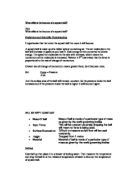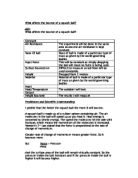The graph, which was produced using the results, shows a gentle curve, which starts from 2.5°C to around 40°C. From this temperature onwards it is seen that the curve of the graph starts to become steeper to in the region of 82°C, where it is observed that the curve starts to level off.
When this detail of the curve of the graph is interpreted it simpler shows the rebound height of the squash ball increasing when the temperature of the ball also increases. The reason for this is as follows:
When the ball is heated the temperature increases and the average speed of the air molecules inside increase, therefore the pressure also increases and the ball becomes incompressible. When the ball is in this state then it has a bigger bounce height then a ball, which has been heated, to a lower temperature.
Another reason for why the ball bounces higher when it is heated relates to the kinetic theory, which is stated below:
‘As the temperature increases, the molecules gain kinetic energy and move faster, so each collision on a surface creates a bigger force and, if the gas is in a closed container, the pressure goes up. If the temperature is decreased, however, the molecules lose energy and move more slowly, so that, in theory at least, there must be a temperature at which they would lose all their energy and stop moving, and the temperature could go no lower than this.’ (Secondary Source-Encarta Encyclopaedia)
The above theory is true of this experiment as when the squash ball was heated, the atoms inside the ball started to vibrate more due to more energy (in the heat form) being applied. So as the temperature of the ball became warmer the atoms inside the ball began to vibrate more vigorously. Therefore when the ball was dropped the pressure inside the ball increased causing the ball to bounce higher.
It can also be seen from the graph that the curve starts to level off between 82°C and 90°C. The reason for this is that the kinetic energy, which the ball gains when it is heated, starts to gradually slow down and ultimately cease. This is due to the ball getting nearer to a critical temperature where it would finally start to melt. At this point the atoms inside the ball will gain such an amount of energy that they will eventually break there bonds and thus start to become a liquid.
‘…As the temperature increases, the average speed of the air molecules will also increase. Therefore the pressure increases and so the ball becomes less incompressible and hence will bounce higher than a ball, which is more compressible.’
‘…When the ball is heated the average kinetic energy also increases hence the atoms inside the ball vibrate more, therefore the ball will become more incompressible. When the ball is incompressible it should, in theory, bounce higher.’
The above statements are the predictions that were made in the plan, before the main investigation began. If I compare these predictions with my results it can be seen that they support them accurately. By using secondary sources the above predictions were made, so it can be said that the predictions were intended to be correct.
Evaluation:
The investigation went very well, as it clearly demonstrated the affect of temperature on the rebound height of the squash ball. The results that were obtained were sufficiently reliable and concordant to draw a graph and form a firm conclusion. However there can be improvements made to the investigation if it is repeated, these could be:
-
The results that were made could be repeated more than three times to get a better and more accurate outcome. The temperature range could be repeated to about 100°C, which would then provide more results and hence give a more evidence for the conclusion.
- To make the reliability of the evidence even more accurate a much more accurate thermometer could be used to measure the temperature of the water bath. By accomplishing this the temperature will be measured to a greater accuracy and hence improve the consistency of the evidence.
- To provide a much more accurate reading of the rebound height a digital camera could be used. This method would give more accurate results as the video could be transferred into frames where the rebound height of the ball could be easily seen due to the camera stills.
It can be seen on my graph that there are two slightly anomalous results where the temperature is 2.5°C and 70.5°C. The reason for this could be the following:
- The main reason for this could be that when the rebound height was recorded using the normal human eye, the measurement that the ball actually rebounded back on may have been interpreted incorrectly hence leading to the anomalous results in the graph
- Another reason for this could be that the squash ball was not put back into the water for a short period of time when attempting the second or third drop.
Overall the experiment went according to the plan that was made, and therefore it worked out to be a good investigation where the results were collected reliably enough to make a conclusion, which was firmly supported.
Extension work
Another way in which this experiment could be performed could be either to carry on with this type of investigation where the temperature of the ball is still the variable factor or to test out another factor as a variable.
If the same type of investigation were to be outlined than a different way to perform this experiment would be to use a digital camera to measure the rebound height of the ball. This would be an improvement as the digital camera would cut out human error and therefore provide us with much more accurate results.
The way that the camera would work would be to take still images of the ball when it is dropped, by doing this the maximum point at which the ball bounces back onto will easily be observed, due to the slow playback of the images.
The other way in which the investigation could be performed could be to use a totally different varying factor altogether. By using a different factor a contrasting aspect of the experiment will be achieved (the use of a digital camera could be used in this part as well). The factors that could be varied could be any one of the following:
- Diameter of the ball
- Temperature of ball
- Mass of ball
- Acceleration due to gravity
- Height of drop
- Type of Surface
- Pressure inside ball
- Material of ball
This would be an improvement, as it would give a different aspect to which factors affect the bounce of a squash ball. The experiment, which is then undertaken, would be an improved but different angle of this investigation. This would then yield better and more accurate results.








